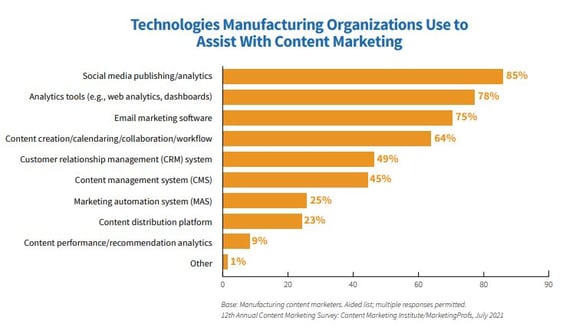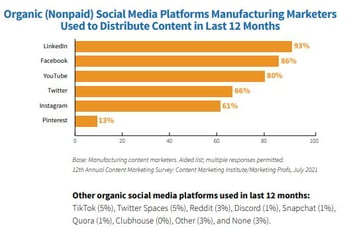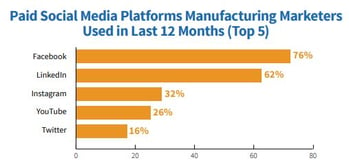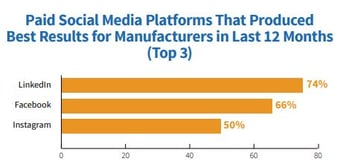 When you hear the term “social media marketing,” what comes to mind first?
When you hear the term “social media marketing,” what comes to mind first?
Maybe it’s Apple’s “Shot on iPhone” social media campaign, where breathtaking photographs are put on display to show off the awesome power of their smart phone cameras. Or maybe Spotify’s annual “Wrapped” campaign comes to mind, as the year’s most popular artists and songs are shared across social media in the weeks leading up to each new year.
Whatever the case, my guess is that your first thought was something consumer-facing and “fun.” In the digital age, B2C companies go out of their way to reach us on whatever our favourite social platform is, and so these types of campaigns are the ones most often associated with social media marketing.
Though more challenging in some respects, social media marketing is also a very powerful tool for manufacturers and B2B companies. When executed correctly, social media offers manufacturers another digital means of generating leads, promoting content, and fostering positive brand recognition and reputation.
However, not all social platforms are the same. In this blog, we’ll use survey data to examine which social media platforms produce the best results for marketers trying to reach engineers. We’ll first look at non-paid social usage so manufacturing marketers can get a better sense of which platforms they should have a presence on, and then we’ll turn our attention to paid social media usage, so marketers have a better sense of where to spend their digital ad budgets.
Social Media Usage and Content Marketing: A Recipe for Success
In our last blog post, we looked at content marketing and the manufacturing industry. How important is content to technical marketers? How much budget and attention are they giving to things like blog, video, and webinar production? And what roadblocks, if any, are preventing marketers from achieving their goals?
All these questions and more are answered in that blog, which you can access here.
However, we want to take a moment to emphasize the connection between content and social media. In many ways, these two marketing activities go hand-in-hand. Your team can create the best piece of content, but if you don’t have a means of distributing that content then few will ever see it. The opposite is also true: you could have a massive social media following, but if you don’t have anything to share, or you share low quality content, then you’re not utilizing your following and overtime people will drop off or unfollow.

A strong social media presence allows your high-quality content to reach a broad audience. In fact, the Content Marketing Institute (CMI) published a report using survey data they collected from marketers in the manufacturing industry. When these marketers were asked which tools they relied on most to assist with content marketing, “social media publishing and analytics” was the most popular answer with 85% of respondents selecting this.
Combining quality content creation with social media is one path to success for marketers in the manufacturing industry. As such, we strongly encourage you to go give our last blog a read once you finish this one!
Non-Paid Social Media Channels
Just because you can have a presence on all social platforms doesn’t mean you necessarily should. We recommend doing your own homework to determine which social sites best match your target personas; no two companies are exactly the same, so you’ll want to examine user data for each of the big platforms to determine which are right for your organization. With that said however, let’s examine which social channels manufacturing marketers have a presence on according to self-reported data, and then we’ll examine which of these are the most effective at producing positive results.
Usage by Platform
 In terms of usage, manufacturing marketers are closely aligned on the three main platforms they rely on. LinkedIn (93% of manufacturing marketers), Facebook (86%), and YouTube (80%), have the highest usage rates across the industry, with Twitter (66%) and Instagram (61%) sitting a little farther down in the middle of the pack.
In terms of usage, manufacturing marketers are closely aligned on the three main platforms they rely on. LinkedIn (93% of manufacturing marketers), Facebook (86%), and YouTube (80%), have the highest usage rates across the industry, with Twitter (66%) and Instagram (61%) sitting a little farther down in the middle of the pack.
Aside from the big five mentioned previously, manufacturing marketers report usage rates below 15% for all other platforms. We’ll look at effectiveness in a moment but suffice it to say that there is a strong reason why LinkedIn sits comfortably at the top of this pack.
Platform Effectiveness
 Far and away, the most effective social media platform for manufacturing marketers is LinkedIn, with 79% of respondents selecting this as a top producer of results in 2021. The next-highest answer was YouTube with 35% - a steep drop-off.
Far and away, the most effective social media platform for manufacturing marketers is LinkedIn, with 79% of respondents selecting this as a top producer of results in 2021. The next-highest answer was YouTube with 35% - a steep drop-off.
When we consider the demographic makeup of LinkedIn, we quickly understand what makes it such an effective platform. Let’s look at the second most effective platform for comparison: in 2021, the largest age group of YouTube users was the 15-25 category while for LinkedIn the largest age group was the 46-55 category. LinkedIn’s user-base skews older because it is a network for professionals. This is exactly the kind of audience that manufacturing marketers are hoping to reach, so it’s clear why this social platform produces the best results. If your B2B organization doesn’t already, you should absolutely maintain some sort of presence on LinkedIn.
Further however, you shouldn’t stop at just your company’s LinkedIn presence. The employees of your organization can have just as much of an impact on the platform as your corporate page, if not more! Some of the best content that is shared on LinkedIn comes from professionals sharing their experiences and knowledge with their networks. The more that members of your organization (including executives) engage on LinkedIn with quality content, the more well-known and respected they will become within their professional networks. This will help them to build relationships with others in the industry, including potential customers!
Paid Social Media Channels
Manufacturers also have the option to promote their organization through paid advertising on social media platforms. In fact, last year 85% of manufacturing marketers reported that they utilized paid methods of some kind to promote content, and of these 77% said they specifically used paid methods to promote content on social media platforms. This works out to approximately two-thirds of all manufacturing marketers using paid social media promotion.
The amount of budget you allocate to these initiatives, as well as the quality and creativity of your advertisements will both have major impacts on your paid campaign’s success. However, your first decision must be which platform to engage on.
Once again, let’s look at which platforms technical marketers are using paid methods on, and then look at which ones they reported having the most success with.
Usage by Platform
 In terms of where marketers are spending their social media advertising budgets, surprisingly Facebook edges out LinkedIn for the top spot. Though very close in usage rates (76% of respondents reported using paid Facebook advertising vs. 62% of respondents saying the same for LinkedIn), ultimately Facebook comes out ahead.
In terms of where marketers are spending their social media advertising budgets, surprisingly Facebook edges out LinkedIn for the top spot. Though very close in usage rates (76% of respondents reported using paid Facebook advertising vs. 62% of respondents saying the same for LinkedIn), ultimately Facebook comes out ahead.
Given the figures we just saw on the usage and effectiveness of non-paid platforms, as well as the figures we’ll look at below for effectiveness of paid (spoilers – LinkedIn advertising was selected as the most effective by the highest number of respondents), this is a bit surprising. However, we think the answer to this seemingly counterintuitive result lies in the audience size, targeting parameters, and metrics for success on each platform. More on this in a moment…
Platform Effectiveness
As hinted at, LinkedIn was selected by the greatest number of respondents as the paid social platform which produced the best results in 2021 (74% of respondents for LinkedIn vs. 66% for Facebook). To understand this, we must consider what the goals are for advertising on each platform, and how each platform allows advertisers to target users.
 Facebook’s ad targeting parameters are more focused on things like demographics, personal interests, social groups, and browsing activity. LinkedIn on the other hand, allows for targeting based on profession, job title, industry, company of current or past employment, etc. As a result, Facebook allows advertisers to reach a larger number, but broader set of people (especially when we consider that Facebook has around 2.8 billion monthly active users vs. LinkedIn’s 64.7 million). This sort of targeting lends itself well to generating brand awareness, which very well might be the goal of marketers that use this platform.
Facebook’s ad targeting parameters are more focused on things like demographics, personal interests, social groups, and browsing activity. LinkedIn on the other hand, allows for targeting based on profession, job title, industry, company of current or past employment, etc. As a result, Facebook allows advertisers to reach a larger number, but broader set of people (especially when we consider that Facebook has around 2.8 billion monthly active users vs. LinkedIn’s 64.7 million). This sort of targeting lends itself well to generating brand awareness, which very well might be the goal of marketers that use this platform.
On the other hand, LinkedIn allows for very direct targeting of people who we know for certain share a professional interest in manufacturing content, because they work in the industry or at the companies that manufacturers are trying to target. So, even though LinkedIn’s audience might be smaller, it’s also more likely to generate leads (relative to impressions, of course) because of the power and detail of the targeting parameters. Facebook ads allow manufacturers to get more eyeballs overall on their content, but a smaller percentage of those eyeballs are likely to click or convert. In addition, brand awareness is a hard metric to quantify, so it’s possible more survey respondents selected LinkedIn as most effective because it generated more measurable interactions or conversions.
Another piece of interesting data from this question, was how well Instagram performed relative to its usage. Only 32% of marketers said they utilized paid Instagram advertising in the last 12 months, but 50% of respondents selected Instagram as a top producer of results. This signifies that the relatively small number of paid Instagram advertising users experienced a high degree of success.
How Effective is Social Media Marketing, Really?
The answer to this question will largely depend on what you set out to accomplish with your social media marketing campaigns. The survey data we’ve presented in this article clearly shows that 1) social media marketing is used by a majority of technical marketers, 2) certain platforms are more effective at achieving positive results than others, and 3) two-thirds of technical marketers are utilizing paid methods of promotion on social media. Let’s discuss each of these findings in more detail.
1. Social Media Usage
The fact of the matter is that you should maintain some sort of presence on social media. Existing and potential customers expect you to be there, and it’s likely that all of your major competitors are there as well. The fact that 85% of marketers reported using social media publishing to support their content creation program should come as no surprise. Simply existing on and utilizing social platforms is a no-brainer, and there is little to no downside to maintaining a presence.
2. Achieving Positive Results with Certain Channels
This finding obviously begs the question: what exactly are “positive results”? It’s left up to the respondent to determine what “positive results” means to them, meaning it could be anything from general brand awareness to actual lead generation from a social media post.
Speaking from our experience at engineering.com, many of our partners and customers have found social media to be an excellent tool for awareness building but a lacklustre tool for lead generation. The fact of the matter is that social media is a cluttered space filled with quick, digestible content. It’s relatively easy to get someone to scroll past your post, read a headline, register your brand, and then move on, but it’s an entirely different and more difficult thing to have them click through to your site and convert as a lead. Certain channels will, of course, be better at this than others (which is likely why LinkedIn is seen as the favourable platform for respondents), but you could never rely on social media alone to be your lead generation engine.
The data does not quite reflect this reality. While 79% of respondents said LinkedIn was the platform that generated the best results over the last year, these results are in relation to other social platforms. If, for example, Email Marketing was added to the list of options alongside social platforms, we suspect this answer would overtake all others for the top spot. Organic social media marketing serves a purpose as one of many tools in a marketer’s toolbox, but our expectations for what “positive results” are exactly, are still relatively low.
3. Paid Promotion on Social Media
Two-thirds of respondents reported using paid methods on social platforms over the last twelve months, but this begs the question: to what extent? Yes, they are utilized, but how much budget is being allocated to these campaigns?
Paying per click on social media campaigns can get very expensive, very quickly. If the goal of your paid campaign is simply to generate broad-based awareness for your brand and you’re more focused on paying for the impressions than clicks, then this can be a powerful tool for your marketing team. However, if you are focused on lead generation, be prepared to dedicate a fair chunk of your budget if you want to generate a meaningful number of leads on these platforms.
Oftentimes it can make more sense to advertise with specific publications, industry groups, or communities. People are inherently distrustful of advertising on large social sites, but advertising on a smaller, more intimate community platform can feel more trustworthy and legitimate. Community members trust the administrators of the site or group to vet advertisers ahead of time for quality, reliability, etc. In the end, this form of paid advertising can often return more bang for your buck than broad-based advertising on social platforms.
Share Content; Gain Awareness; Generate Leads
Social media is a powerful tool for all technical marketers, including those in the manufacturing industry. In addition to the specific findings we’ve discussed in this article, we can also see that there is a broad consensus amongst users that the pros of using social media marketing do indeed outweigh any cons. Social media is one of many tools that technical marketers should be utilizing, but like any good investment strategy diversification is key and you shouldn’t rely on social platforms alone to carry your team across the finish line.
We hope you’re able to utilize some of the insights from this article to inform your social media strategy, and to distribute your content more effectively!
To read our blog on content marketing and manufacturing, click here. To access the full survey report from CMI, click here to visit their site.
If you have any questions or comments about this blog article, including your experience using social media to distribute quality content, then leave us a comment down below!





